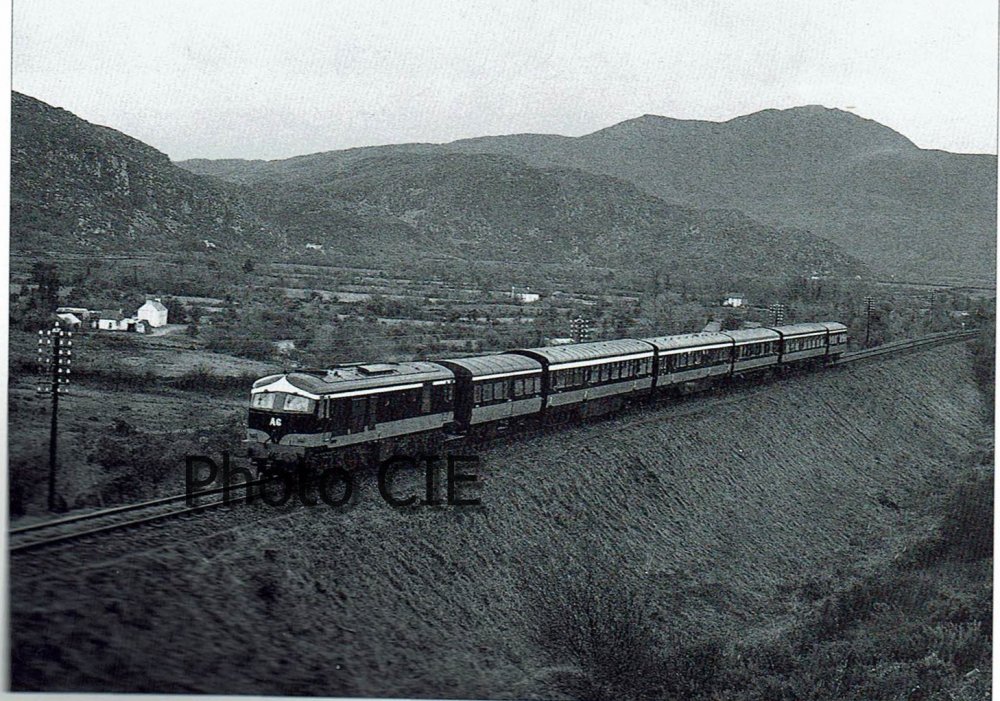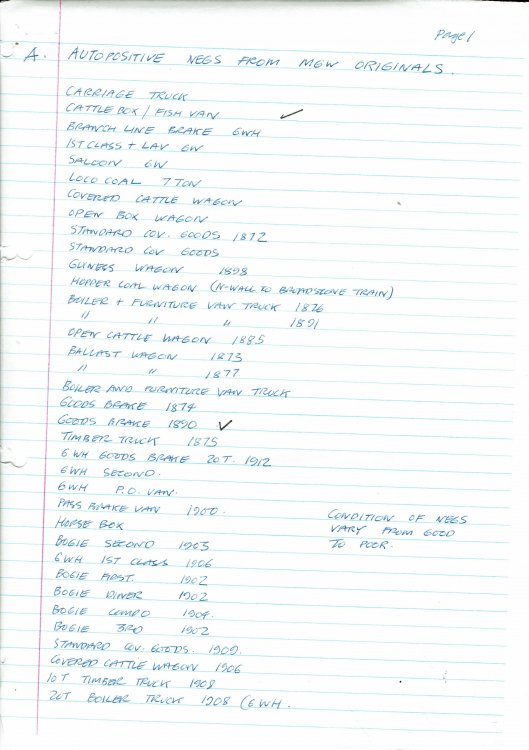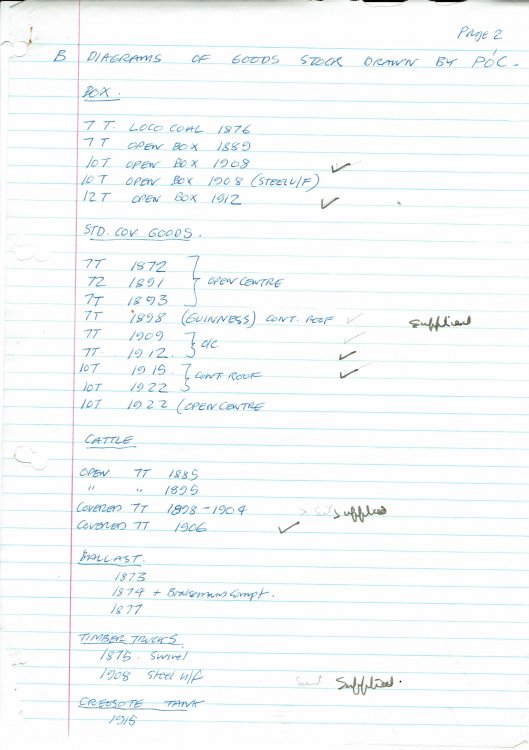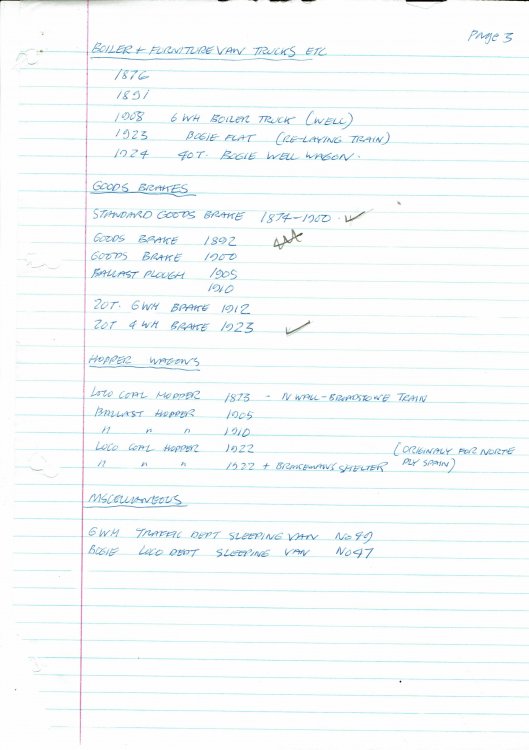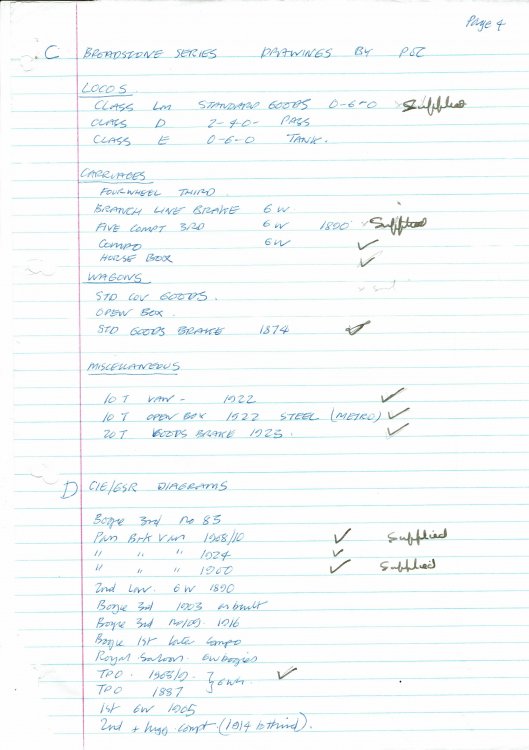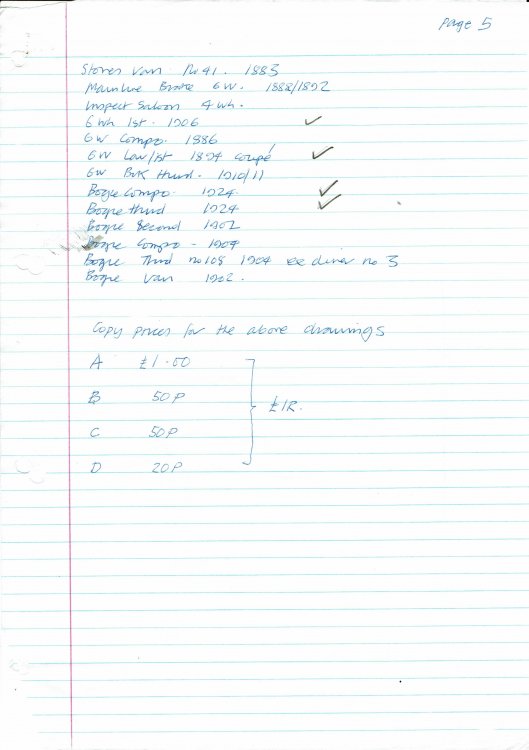-
Posts
4,871 -
Joined
-
Last visited
-
Days Won
119
Content Type
Profiles
Forums
Events
Gallery
Blogs
Store
Community Map
Everything posted by Mayner
-
I think the low level of interest in anything pre-1980 is more a matter of demographics than the lack of availability of rtr models or kits. The Murphy Models black and tan Bo-Bos and CIE Cravens do not appear to have sold as well as the same stock in IE livery. This seems to be borne out with IRMs identifying a greater level of demand for IE rather than CIE era freight stock. For anyone determined enough Worsley Works produce parts for most of the 1950s era railcars including AEC, BUT, MED. Colin Flannigan has built a lot of 1950s stock using rtr coaches with Worsley Works sides, while Kirley has covered the building of the Worsley Works railcars in his workbench thread.
-
The "white engines" frames turned out to be in better condition than they 1st looked, so I am planning to re-assemble the frames and running gear as a replacement chassis for 193. This will bring 193 mechanically into line with 191, with similar compensated chassis, wheels, motor and gearing should be good for another 30 years hopefully! Dismantle chassis before clean up. A dunk in airbrush cleaner removed oil, grease and most of the paint, excess solder removed with an old file. I will re-use the frames, motion bracket and compensation beam and fit L & U shaped fold up frame spacers. I thought it worthwhile to set up the running plate and valences on one of the new locos to check clearances within the splashers for 21mm gauge wheelsets. Most of my 21mm gauge steam locos are fitted with Mike Sharman B profile wheels which were intended for OO/EM use but have a tyre width of 2.03-2.06 rather than the 2.28mm recommended by the EM Gauge Society and used by a number of British wheel manufacturers including Ultrascale and Alan Gibson Workshop. While 191 & 193 operated satisfactorily, there were clearance problems with the white engine with the wheel tyres occasionally shorting on the inside of the splashers. The J15 running plate is designed around a base plate, which incorporates inner splashers, buffer and drag beam to which the valences are attached, the valences are reinforced with sacrificial plates to help keep the running plate assembly flat while the locomotive body is assembled. I used an "Etchmate" bending tool and an engineers square to fold up the splashers from the running plate. Test Running board with valences attached. I fixed the baseplate to a piece of MDF (cut slightly narrower and shorter than the baseplate) with small woodscrews before soldering the valences to the baseplate. I test fitted a Mashima 10X20 Motor and High Level-Road Runner gearbox to the chassis to check clearances within the body before making a final decision on mounting the motor. There is sufficient space to mount the motor at a slight angle from the vertical within the firebox, though I would prefer to mount the motor horizontally within the firebox & boiler and fit a flywheel. Sharman wheels 19.5mm back to back overall width of wheelset 23.56 Min width between splashers 24.56 0.5mm clearance each side between wheel set and side of splasher Alan Gibson wheels 19.3mm back to back overall width of wheelset 23.76 (0.8mm shims between wheel set and splasher) Min width between splashers 24.56 0.4mm clearance each side between wheel set and side of splasher. The wheel set is mounted on a 1/8" extended axle available for outside framed locos. RP25 110 (Hornby) Tyre width 2.60-2.66 19.3mm back to back overall width of wheelset 24.62 Min width between splashers 24.56 Clearance between wheel set and side of splasher Zilch! During the test assembly I noticed that the distance varied between splashers on all three axles, with clearance at the center axle tightest. I will check align the splashers using a steel straight edge before attaching the running board overlays and outer splashers. Clearance appears to be adequate for assembly with EMF profile wheels with minimal sideplay which will restrict the locos to curves of 3' radius or greater. RP25 110 & Markits wheels would be a non runner with a J15 and the majority of Irish steam locos even if suitable wheels and axles were available.
-
The GSWR 6 wheelers are going through the paint shops. The whole process was going well until the daytime temperature dropped 7-8° on Mon and I got caught out while trying to prime the brake 3rd. Luckily enough a dunk in airbrush cleaner removed all the paint, thanks to all metal construction and solder assembly. Body components & bogies primed. Underframes in the spray booth Day 1 The SSM coaches break down into sub assemblies for painting. I generally warm to model and the spray primer on top of a radiator before priming. The primer is an Australian etch primer which does not classified as a corrosive substance (may not contain phosphoric acid) and appears to depend on solvents to etch the substrate. I have used it for about 10 years on brass and it appears to be fit for purpose. Day 2, Dark grey general primer on 1st & roofs, underframe parts sprayed satin black. Floor and interior partitions cut from plasticard, pre-formed seating. I had an anxious moment trying to find the ventilators that fit above the carriage doors, luckily I found enough for the passenger compartments. I am planning to paint these coaches in the GSR maroon colour scheme (similar to LMS) used from the mid 1930s onwards.
-
I sometimes wonder if the G Class were introduced with the intention of using them to station staff rather than drivers operating the locos at the larger wayside stations and smaller yards. Shunting tractors like the Duetz were in widespread use on the Continent, at one stage nearly every medium sized New Zealand Railways station had a shunting tractor usually driven by a depotman or shunter. Currently rail tractors are used mainly at industrial sites for shunting/marshalling rakes of container wagons for collection by Kiwirail from private sidings.
-
There is a CIE publicity photo of a "Modern Passenger Train" made up of A6, what appears to be a trio of powered intermediates and the state coach. A6 was the guinea pig for the black and tan scheme, the powered intermediates converted from the Bullied slab fronted railcars around the same time. The railcars still have their side skirts hiding the mechanical bits. The formation of hauled railcars on a mainline passenger train appears odd, the last vehicle appears to be a luggage rather than a heating van. Were the railcars used because they were the only black'n'tan coaches available or to provide a means of getting the President home with the least disruption if A6 broke down.
-

EM/OO Fine standards applied to Irish 5'3" gauge track.
Mayner replied to Mayner's topic in Irish Models
Ultrascale will supply 21mm loco and rolling stock wheel sets to order to either EM or S4 wheel profile. 9 month order lead time but a very high quality product that will run through and probably outlast the buyer. -
Ivan: Apart from yourself there has been little or no interest in the Z boiler conversion kit. The conversion etch is one of my early designs, there are a number of assembly issues which I need to highlight or eliminate before I could consider selling the etch to the public. I will review the situation once I have assembled the superheated loco. If there is sufficient demand (8 or more in this case) to offset the cost of a new photo tool I will revise the artwork, if not the potential buyer should be in a position to make a decision if the conversion etch meets their requirements.
-
I ended up modelling the 101 Class almost by accident. I set out too many years ago with the intention of modelling the Mayo Road in the 1950s & scratchbuilt a number of locos including a 650 Class and a 594 Midland standard goods, ten along came the TMD J15 in 1985-85. My early scratchbuilding efforts ran reasonably well but looked a bit rough, I was impatient and did not have the steadiest hand with the piercing saw. I scrapped my scratchbuilt engines keepings the wheels gears and motors castings and other bits with the intention of building replacements, but I am only getting round to it 30 years later, though I did build quite a few brass and whitemetal kits both Irish & UK. I seem to go through a pattern of building a J15 every 8-10 years and currently have a total of 5. Two working, one part built and two unbuilt kits. I 1st assembled 193 (loco on left) between 1986-7, it did not run the best so I rebuilt it 7-8 years later and flowed up with 191 in 1995. I acquired my 3rd J15 as part of a job lot of part built & unbuilt TMD/SSM kits at Expo EM around 2000, the builder of this loco had attempted to assemble the loco with a compensated chassis to S4 standards and ran into problems with the chassis assembly. I acquired a further pair about 10 years ago, when my modelling interests turned towards the Limerick-Sligo line where the 101 Class handled the majority of freight workings from the Amalgamation to the end of steam. The basic idea is to retire 193 and have 4 locos available for freight service, with at least one with a superheated boiler and heavier frames, to free-up a set of frames. I prepared a set of test etches for converting the SSM kit, I hope to cover off the test assembly of the superheated loco using these parts in the thread. I though it would be useful to review how I approached the challenge of assembling and motorising 193 & 191, before considering the build completion of further locos. 191 & 193 have different motors and gearboxes, and I decided to standardise on Mashima 10X20 motors and Branchlines Road Runner + gearboxes on the "new" locos to bring a bit of standardisation into the fleet. A bit like the GSR my attempts at standardisation will only add to the variety of the fleet. 193 has lost some of her tender springs and 191 some of its tender axlebox covers which were glued on, I soldered them on to the white engine! 193 has a sprung chassis, with Anchorage DS10 (Tenshodo?) open frame motor and Sharman milled brass gearbox with 40:1 reduction gearing, Sharman B profile wheels set to 21mm gauge with a back to back of 19.5mm. Pick up is through the axles and bearings on the "American system" with the loco picking up power on the opposite side to the tender, the driving and tender wheels are shorted out on one side with fine brass wire. The phosphor/bronze wire soldered to the frame space may be to aid power pick up from the axle to the frames and motor. This system has operated reliably at exhibitions and at home except when I lubricated the bearings with a Labelle oil for the Inchacore 150 Exhibition. I flushed out the bearings with a solvent and oiled the beraings with my usual Fleishmann oil and the locos ran perfectly on the second day of the exhibition. Initially assembling the chassis almost defeated me, I fitted new frame spacers, sprung hornblocks and flywheel during the 1993-4 rebuild, unfortunately I discarded the brake gear during the 1st attempts at assembling the loco as I did not have any suitable bits to drill 0.45 or 0.7mm holes. The DS10 motor was one of the smallest available at the time and is a bit high revving for a goods loco, the Sharman gearbox is fully enclosed with an Ultrascale 40:1 gear set. I will probably re-use the motor and gearbox in a passenger loco when 193 is retired from service. 191 is fitted with a Mashima 12X24 motor and Branchline Slimline open frame gearbox with 80:1 gearing, which gives more realistic handling and top speed for a goods locomotive. This loco is fitted with a compensated chassis with a fixed rear axle and the leading and driving axle free to move up and down approx .5mm from center. Smoother slow speed running compared to a loco with a rigid chassis (as a result of improved pickup with all 6 wheels in contact with the rails) is probably the main benefit of a suspension system in a small loco. I build my locos in removable sub-assemblies to allow a loco to be dismantled for painting, and maintenance. The loco brake hangers and pull rods are a removable sub-assembly, which allow the wheels, gearbox and motor to be dropped out. I soldered a piece of brass rod to the brake stretcher bars to reinforce a very fragile sub-assembly. The brass strip under the tender is an afterthought that serves the same function! The insulated loco-tender drawbar is a piece of C&L abs plastic sleeper strip, power connection between the loco and tender is a very neat single pin connector that was sold by a UK kit/part supplier possibly Crownline or Comet at exhibitions. 191s compensation beam may also perform a power pick up function. The "White Engines" frames after removal of hornblock system. The white engine was originally fitted with an early version of the Perseverence Hornblock system and a Mashima motor and Branchlines gearbox similar to 191. I initially tried to re-use the chassis with the minimal amount of effort, by reaming out the existing bearings and fitting Sharman B Profile wheels. The original builder had become stuck at the same point with a number of engines and gave up in frustration, mainly weak soldered joints possibly as a result of insufficient heat soldering frames to spacers and axles seizing in their bearings due to a combination of inadequate preparation and flux contamination. I was dis-satisfied with running so I ended up removing the existing hornblocks to fit MJT hornblocks similar to those used on 191, the solder joints between frames and machined brass spacers failed as a result of the heat, so its probably simpler to use one of the nickle silver chassis from one of the un-built kits to get this loco into service, than try and rebuild the existing chassis. The photo also exposes a major weak point of the chassis for a builder who intends fitting a suspension system, there is precious metal left above the hornblock cutouts at the rear of the chassis once the half etched lines are cut out. I fitted reinforcing strips to the rear of 191 & 193s chassis as a result of a lesson learned during my first attempt at assembly of the same loco. There has been a lot of development in fine scale chassis since I 1st assembled 193, I am looking at the feasibility of fitting the 3 new chassis with a continuous beam suspension system which has become popular during the past 20 years rather than compensation like 191 or sprung hornblocks like 193, I am also looking at the pros and cons of mounting the motor in the tender with a flexible drive to the loco compared with mounting the new smaller 10X24 motor between the frames in order to maximise weight in the boiler and firebox and increase adhesion weight.
-
Fitting ETH to some of the C Class seems to have been part of a last ditch attempt to provide heating on passenger and mixed trains on short feeder branch lines in West Cork and in the Midlands and West of Ireland. The saga of CIEs attempts to provide electric train heating on branch lines worked by diesel locomotives is covered in an earlier Irish Railfans News. Apparently an number of bogie coaches were converted to "self heating carriages" for branchline use with C Class locomotives by fitting small generator sets. The self heating carriages appear to have been intended for use on the one coach mixed train on the West Cork Branches, Ballina & Birr. The generator sets do not appear to have been too successful in operation and some C Class were fitted with ETH shortly before the West Cork & Valencia branch lines closed, leaving Ballina & Birr as the only branch lines with a diesel worked passenger services. Birr closed and Ballina lost its passenger connections from Manulla in 1963 leaving little or no regular passenger work for the C Class. Funnily enough there is a nice photo 1968 photo in the Irish Metrovicks book of a freshly re-painted C203 with silver ETH connection on buffer beam although in all probability the handful of eth fitted coaches had been withdrawn. In the photo C203 looks very smart in all over black livery with yellow warning panel & buffer beam, white cab band, tiny air horn and windscreen wiper on drivers side only. .
-
Probably better to start out with a wagon or small 0-4-0 or 0-6-0 loco, than a large 4-4-0. 4-4-0s are difficult to balance and may be difficult to set up the kit to run on anything less than a 3' radius curve even in OO. Alan Elgar's built a GNR(I) Vs Class out of an SSM "Merlin" kit in connection with RMWeb/BRM "build a loco challenge". Alan's thread provides a good overview with plenty of photos of whats involved in assembling the kit. http://www.rmweb.co.uk/community/index.php?/topic/98951-gnr-ireland-vs-class-4-4-0-a-skritchbuild-in-4mm/
-
Reality TV is all about personalities (the more extreme the better) and impossible timeframe/challenge to spice things up. I always loved the garden make over programme where they sealed a freshly plastered garden wall with polybond and immediately painted it, the paint was almost guaranteed to fall off in a couple of days. Combination of the X Factor and Hell's Kitchen would do wonders for the image of the Hobby. All that's needed is celebrity modelers as judges & team mentors, Neil Young, Pete Waterman & Rod Stewart would fit the bill though not sure if they meet the extreme personality test. Wonder do Simon Cowell & Gordon Ramsey play trains?
-

Narrow Gauge in the Rockies not quite
Mayner replied to Mayner's topic in US / Canadian Railway Modelling
Not in the Irish or British sense. Basically a boarded area at track level at the front of the depot, similar to the existing decking. The replica Dolores depot is a mirror image of Orphir, it was built as a starter project by the local community (pop 900) before they took on the restoration of RGS Motor 5 and a short demonstration track. Unfortunately we were running late on the day and did not get a chance to check out the museum, I will have to go back sometime and spend more time in the area. -

Narrow Gauge in the Rockies not quite
Mayner replied to Mayner's topic in US / Canadian Railway Modelling
After a brief spurt of activity preparing for a garden railway convention in 2011 the Jackson County has been pretty neglectful about providing covered accommodation at Jackson City for its staff and the very odd passenger that might want to ride the line. After toying with the idea of a NZR style building, I settled on Ophir Depot on the RGS as a potential depot/company head office. A rating valuation elevation and floor plan are available on line, a reasonable start for designing a mock-up to see if it would fit/not over dominate the scene. The real Ophir Depot was on the inside of an almost 180° curve, Jackson City Depot will be on the outside of a 90° curve. I planned the mock-up/shell of the building in 12mm treated ply, buying 2 1200X600 panels from a local DIY warehouse, funnily enough 2X600X1200 panels were $6 cheaper than a single 1200X1200 panel, be interesting to see how a full 1200X2400 sheet works out. Plywood is manufactured from locally grown Radiata Pine which is fast growing and tends to twist all over the place, even when bonded into a sheet of ply. I cut out the basic outline of the platform elevation with a battery powered skilsaw and cut out the window opes with a drill and a jigsaw. I was a bit worried that a 1:20.3 scale building might over-dominate the scene, so did a mock up with the basic elevation and depot floor, before cutting out the door and window openings. The ground floor of the building was clad with a combination of horizontal and vertical weatherboard, the roof and upper storey in shingles. The weatherboard is a Midwest Scale basswood product, the lower panel edge is rebated to disguise horizontal joints the top strip overwidth to compensate. I cut out the window and door openings using a sharp craft knife, openings will be trimmed with L shaped strip to form the timber flashings used round doors and windows with this form of construction. The weatherboard is temporarily fixed in place with double sided tape. The section below window level was clad in vertical weather board with a dado rail between the two cladding systems, the large opening between the doorways is for a bay window which incorporated the telegraph operators office. I am looking at the option of laser cutting for forming doors and windows, fixing individual shingles to the roof and upper story would be time consuming but could be very therapeutic depending on your outlook Ophir Depot like most on the RGS was a combined depot and freight house for LCL traffic and seems to be reasonably in proportion for the site without reducing to 1:22.5 or 1:24 Scale -
It looks like an attempt to secure the future of the EM gauge society. The Society have commissioned Peco to manufacture the track, which will be sold to members through the Society store and to the general public at the Societies Expos. Its possible that the society is faced with falling membership as a result of the improvement in the standard of OO gauge rtr models over the past 20 years. A leading British wheel manufacturer recently told me that demand for EM wheel sets and axles had fallen considerably and was planning to discontinue supply once stocks were exhausted, rather encouragingly overall demand for wheels and detail parts remains buoyant and he has recently invested in new machinery It may be that people are content to stick with OO because of the improved running because of improved mechanisms and near universal of NMRA RP25 110 wheel sets compared with what was produced in the 70s & 80s, people who are more concerned about more accurate track and wheel standards are selecting S4 rather than EM. I am not sure on the merits of a 21mm Gauge Society, I think an overall society/lobby group similar to the National Model Railroad Association to represent Irish Modellers broad and narrow in all scales, both to advise on standards and provide a repository for information and potentially models and layouts of historic modelling significance.
-

Narrow Gauge in the Rockies not quite
Mayner replied to Mayner's topic in US / Canadian Railway Modelling
November operating session Tidied up the loco shed after 5-6 years exposed to the Waikato weather. Repaired/replaced window surrounds that had fallen off, re-painted cut checks in door heads so larger locos can fit inside! RGS Motor 6 sits on the turntable. The RGS converted old cars into railcars and an open rail truck in the 1930s, interestingly most if not all of these vehicles survive in working order in the States. The turntable works and is basically a piece of decking board that pivots around a coach screw on some plate washers and has given very little trouble in 8-10 years service. Busy west end of the yard 464 on the main line with a westbound stock special, 463 waits to follow with a way freight while caboose 401 on the end of an eastbound freight waits for her loco to back on once the stock special has departed. Stock special [asses gondolas under the hopper at Utah Junction. Live steam 278 waits to back on to her train once the stock special has departed and the main line clear for running. Slightly scorched smokebox door, these engines were the Rio Grande equivalent in size and power to the J15, the larger 2-8-2s were introduced from the early 1900s onwards to reduce freight train running costs and probably helped keep the remaining narrow gauge lines open into the 1960s. The nearest to conventional baseboard construction, this section of track is supported on 3/4 construction ply on 4X2 treated timber framing and slopes in one direction to help drainage and avoid puddling. Pond lining is glued to the ply with contact adhesive in a similar manner to membrane roofing ballast and ground cover (8mm to dust screenings) is glued to the membrane with a PVA concrete bonding agent, moss is starting to die off with warmer drier spring weather. I am extending the siding on the right out over a dwarf wall which include what look something like coke ovens. This area is normally shaded with sun only in late afternoon during spring,summer, autumn months. 463 has added tonnage to her train since her last stop and has just picked up two gondolas from the hopper and is probably 2-3 carsover her weight limit for the 3-4% gradient to the covered storage tracks in the shed. -
Interesting similar in general appearance to the H Class except for the cab profile and smaller driving wheels without crankpin splashers. The H Class 2-4-0s were the 1st GNR passenger engine and supposed to be based on an older Dublin and Belfast Junction Railway design. The Ulster, Irish North Western and Dublin and Drogheda were also likely to have used 2-4-0s for passenger work, so the origin of the G Class might take some digging/research The GNR would have used the best of the pre-amalgamation types until there was a need to replace them with more modern locos. Interestingly the GNR introduced the 1st batch of 5 U Class 4-4-0s for secondary work in 1915 possibly replacing the G Class locos on the Irish North Western Line and other secondary routes.
-
MGWR 6w coach kits are on the to do list, I need a couple of trains for my own use. I released kits for the 1889 Horsebox and Meat/Fish Van 3-4 years. The frets for the Horsebox and Meat Van are available to order, most of the castings are available from Dart Castings in their MJT range. Drawings of the MGWR brake 3rd, 4 compartment composite and 5 compartment 3rd appeared in Tim Cramer's series in Model Railways magazine in the mid 70s the composite & 3rd were drawn to 4mm scale but the brake 3rd appeared to be closer to S Scale! I will post a "Broadstone Collection " drawing of the brake 3rd in the resources section, the MGWR was fond of goods brakes with raised lookouts until the introduction of the more conventional 20T goods brake with end verandas in the early 1920s
-
The late Padraig O'Cuimin was the recognised authority on the Midland Great Western and published papers on MGWR coaching and wagon stock in the IRRS Journal in the early 1970s. The paper on wagon stock goes into considerable depth on the evolution of both the "standard Irish convertible wagon that carried both livestock and general goods and the evolution of the Irish Cattle wagon. Basically the railways were forced by the Government to increase the length of convertible and cattle wagons to 14' in the late 19th Century which remained the Irish standard until CIE introduced the longer KN wagon in the 1950s. The GSWR & GNR had large fleets of 14' cattle wagons. The MGWR was a thrifty railway and had a relatively small fleet of cattle wagons, relying on the convertible wagons to handle traffic peaks from the big cattle fairs in the West of Ireland, rather than a large fleet of cattle wagons that were only used occasionally. Unfortunately I don't have the full collection, I will scan and post the drawing marked with a √ to the resources section of this site. 1993 prices quoted by Padraig! The Broadstone Series drawings were AO sized, unscaled, highly detailed and a work of art.
-
Peco are a long way behind other manufacturers in terms of EM track and pointwork. Reasonably priced EM gauge bullhead flexible track has been available from a number of manufacturers for the last 20-30 years, the lack of ready assembled points are less of an issue in EM & S4 for bullhead track as the railway and modelers tend to build custom built formations to fit the available space. Its difficult to see the 10-20 people in the world who work in 21mm having the same level of influence on manufacturers as the EM or S4 Societies. For the average 21mm gauge modeler building/assembling locos and stock and laying track is funner than sitting on a standards committee, which is why nearly every one of us works to their own personal track and wheel standard.
-
Reasonably priced Unimat's come up on e-bay https://www.ebay.co.uk/itm/UNIMAT-3-LATHE-AND-MANY-MANY-ACCESSORIES-CLOCKS-MODEL-ENGINEERING/283247594252?hash=item41f2df4b0c:g:eO8AAOSwnFpb4Xe7 The Unimat 3 is a much more solid machine than the older SL1000 though either type are more than adequate for small scale modelling. The only warning is that you will probably endup spending more on late/milling machine accessories than you spent in buying the machine in the 1st place.
-
The Ulster Folk & Transport Museum have loco and rolling stock drawings from the majority of the Broad and Narrow Gauge railways including GNR(I), NCC,(broad & narrow gauge) BCDR, DNGR, CDRJC and UTA that operated in Northern Ireland. I don't know if the drawings are available to members of the public, but it would be worth while contacting the curator to check on the current position. I have a copy of a 21 page catalogue I got from the museum several years ago, the GNR(I) section contained 87 diagrams of coaching stock and a similar number of freight stock, but no locomotives. CDJR, NCC, BCDR diagrams covered locos and stock. UTA drawings naturally covered railcars and railcar conversions. Irish Railway Record Society Members Brendan Pender and Herbert Richards published the GSWR Carriage Diagram book over 40 years ago, a copy of the book may be available in the IRRS Library or through the IRRS London Area The diagram book contains 59 Diagrams of Bogie stock, 40 diagrams of 6w stock, 13 diagrams 4w stock (non passenger coaching). Richard Chown relied heavily on manufacturers drawings for his 19th Century locos and rolling stock used on Castle Rackrent. UK technological museums like the NRM, Manchester and Newcastle may have original general arrangement and construction drawings for narrow gauge stock supplied by companies like Pickering, Metropolitan Carriage and Wagon.
-
I toyed with the idea of buying a lathe and a milling machine a few years ago and ended up buying a Unimat SL. Manufacture between the mid 1950s and mid 1970s the Unimat DB200-SL1000 was a popular for light modelling work as they can be set up to operate as a milling machine, a lathe and other machine tools. The motor in my Unimat appeared to give up the ghost in June, refusing to run and sparks coming out of the bottom of the motor housing. Luckily enough a local re-wind/electrical repair shop was able to do a repair, it looks like a radio interference suppressor blew up causing one of the motor leads to wrap round the commutator, but not trip the workshop circuit breaker. I set up the Unimat as a lathe last night to reduce the bogie center height on a number of large scale archbar freight trucks. When I replaced LGB & Bachmann freight cars with 1:20.3 (15mm) scale stock over the past few years, I was surprised at the variation in coupler height among AMS/Accucraft freight stock. My stock is a combination of new and used with a variation in height between different types of stock, but more surprisingly between cars of the same type. On checking the coupler height of 3044 was 2.6mm higher than the car on the left and the majority of box and stock cars. Coupler height was lower again on gondolas (opens) & flats but that's another story with an easier solution. I will probably stick to AMS couplers rather than change to Kadee, magnetic uncoupling does not really come into it when you have working coupler lift bars and switch stands, though switching or running round trains can involve a lot of walking on my railway if you don't plan your moves in advance The car on the left has a more recent design of truck with a lower bogie pivot center and different brake hanger design. The archbar trucks are of a similar design to the modern American 3 piece freight truck and the BR "Ridemaster" bogies. Lowering the height of the bogie/truck center. The truck center beam/bogie bolster just about fits in the 4 jaw chuck and clears the lathes bed bars. Centering the center beam was simple enough gradually adjusting the jaws using the lathe tool as a guide. The center beam was close to the limit for the SL in terms of diameter, though rising pieces are readily available for the head& tail stocks and tool post. GSWR 6 wheeler in the background waiting its turn through the paint shop! Before and after shots of early version of AMS archbar trucks, the truck on the right is from a gondola that may have spent more time in a box or display case than the truck on the left. Die casting appears to be of good quality min 12-15 years since manufacture, machined reasonably easy with a good finish. Current design of AMS archbar truck, truck center 2.6 mm lower than earlier design, underslung brake hangers, plated wheels. This basically completes the coupling height adjustments to the AMS stock, the next job is to fit Kadee or AMS couplers to my Bachmann locos and freight stock. Another step closer to reliable operation
-
Atkinson Walker built 25 geared steam locos mainly standard gauge for use in industry. The CVR tractor appears to have been the only one considered to be a failure, possibly CVR loco crew lack of familiarity with firing vertical boilers rather than any inherent failings with the loco itself. http://glostransporthistory.visit-gloucestershire.co.uk/ROD_Universal Works_British steam.html. Atkinson-Walker appears to have gone out of production as a result of the Depression and competition from Sentinel. The Atkinson-Walker business re-emerged in 1933 as Atkinson Lorries a successful British heavy vehicle manufacture, not sure if there was a connection with Walker Bros of Wigan who built diesel railcars from the 1930s onwards.
-
I remember seeing a very smart looking 019 newly painted in the tippex scheme with points loco during a visit to Inchacore during the early 1990s The loco appeared to have been overhauled and re-painted including bogies, but never re-entered service being stored in 010s former resting place outside No1 Diesel. Its possible that it was intended to retain a number of 001 Class for Tara and Liner workings before IE got funding to increase the order of the 201 Class from 10 to 34 locos. Only one cab and about 3/4 of the loco body was repainted for the mock up the remainder of the loco remaining in the tippex scheme.
-
It looks like the loco is in an approximation of SNCB/NMBS (Belgian Railways) livery. The model appears to be based on the German V200 diesel locomotives, there were broadly similar locos in use throughout Europe the Irish assembled V200 seems to have been available in British Rail, Belgian, Danish, German, Norwegian, and Spanish railway liveries.
.png.c363cdf5c3fb7955cd92a55eb6dbbae0.png)



